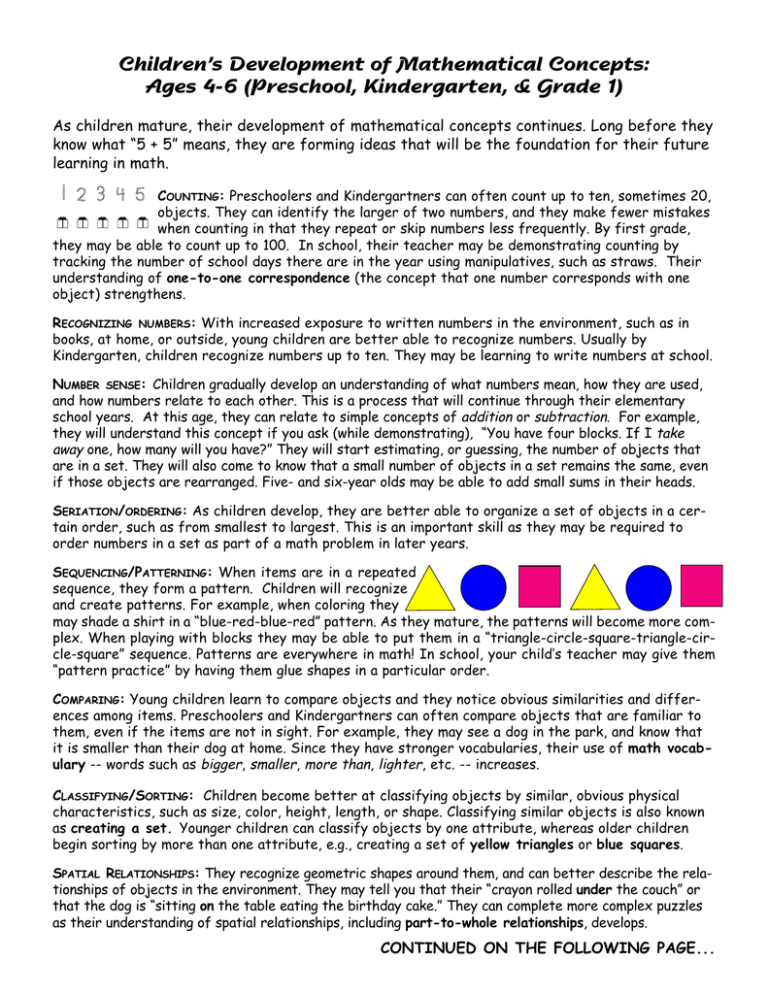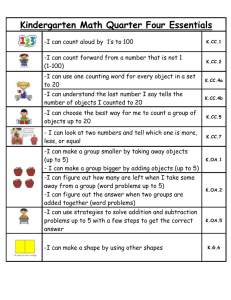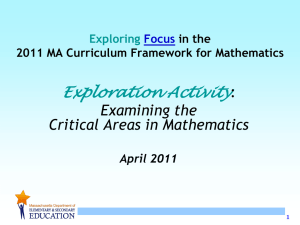Children`s Development of Mathematical Concepts: Ages 4
advertisement

Children’s Development of Mathematical Concepts: Ages 4-6 (Preschool, Kindergarten, & Grade 1) As children mature, their development of mathematical concepts continues. Long before they know what “5 + 5” means, they are forming ideas that will be the foundation for their future learning in math. 1 2 3 4 5 COUNTING: Preschoolers and Kindergartners can often count up to ten, sometimes 20, objects. They can identify the larger of two numbers, and they make fewer mistakes when counting in that they repeat or skip numbers less frequently. By first grade, they may be able to count up to 100. In school, their teacher may be demonstrating counting by tracking the number of school days there are in the year using manipulatives, such as straws. Their understanding of one-to-one correspondence (the concept that one number corresponds with one object) strengthens. RECOGNIZING NUMBERS: With increased exposure to written numbers in the environment, such as in books, at home, or outside, young children are better able to recognize numbers. Usually by Kindergarten, children recognize numbers up to ten. They may be learning to write numbers at school. NUMBER SENSE: Children gradually develop an understanding of what numbers mean, how they are used, and how numbers relate to each other. This is a process that will continue through their elementary school years. At this age, they can relate to simple concepts of addition or subtraction. For example, they will understand this concept if you ask (while demonstrating), “You have four blocks. If I take away one, how many will you have?” They will start estimating, or guessing, the number of objects that are in a set. They will also come to know that a small number of objects in a set remains the same, even if those objects are rearranged. Five- and six-year olds may be able to add small sums in their heads. SERIATION/ORDERING: As children develop, they are better able to organize a set of objects in a certain order, such as from smallest to largest. This is an important skill as they may be required to order numbers in a set as part of a math problem in later years. SEQUENCING/PATTERNING: When items are in a repeated sequence, they form a pattern. Children will recognize and create patterns. For example, when coloring they may shade a shirt in a “blue-red-blue-red” pattern. As they mature, the patterns will become more complex. When playing with blocks they may be able to put them in a “triangle-circle-square-triangle-circle-square” sequence. Patterns are everywhere in math! In school, your child’s teacher may give them “pattern practice” by having them glue shapes in a particular order. COMPARING: Young children learn to compare objects and they notice obvious similarities and differences among items. Preschoolers and Kindergartners can often compare objects that are familiar to them, even if the items are not in sight. For example, they may see a dog in the park, and know that it is smaller than their dog at home. Since they have stronger vocabularies, their use of math vocabulary -- words such as bigger, smaller, more than, lighter, etc. -- increases. CLASSIFYING/SORTING: Children become better at classifying objects by similar, obvious physical characteristics, such as size, color, height, length, or shape. Classifying similar objects is also known as creating a set. Younger children can classify objects by one attribute, whereas older children begin sorting by more than one attribute, e.g., creating a set of yellow triangles or blue squares. SPATIAL RELATIONSHIPS: They recognize geometric shapes around them, and can better describe the relationships of objects in the environment. They may tell you that their “crayon rolled under the couch” or that the dog is “sitting on the table eating the birthday cake.” They can complete more complex puzzles as their understanding of spatial relationships, including part-to-whole relationships, develops. CONTINUED ON THE FOLLOWING PAGE... Children’s Development of Mathematical Concepts: Ages 4-6 (Preschool, Kindergarten, & Grade 1)...continued MEASURING: In school, your preschooler or Kindergartner may be learning simple measurements using non-standard units, such as measuring how long something is using paper clips or blocks, instead of a ruler. They come to learn how to classify objects based on weight (heavy/light); capacity (holds more/less); and length (long/short). However, before age seven, children will not know that the amount of liquid in a short, fat cup remains the same even if the liquid is poured into a tall, skinny cup. They will think that the taller cup has “more” in it because it looks like more. Kindergartners and first-graders may also be learning how to weigh objects using a balance scale and gram weights. TIME: Children this age will have a basic understanding of time concepts. For example, they may know that “five minutes” is a short time - especially if they hear at school, “Clean-up time is in five minutes.” They understand concepts such as morning, afternoon, and night and words that describe time such as before, after, or next, to name a few. In school, they may be learning the days of the week, and how to read a calendar. They learn that a year is longer than a month, and a month is longer than a week, etc. PREDICTING: Through experiences, children start to make predictions about what will happen next. For example, if they see it is raining out, they may predict that there will be indoor recess at school. PROBLEM SOLVING: Children this age can solve simple problems. For example, if you say to your preschooler or Kindergartner, “There are ten grapes and two children. How can we make sure that each of you gets the same number of grapes?,” they may use their skills in counting and grouping to make sure each child gets an equal number. In school, they may be learning how to draw pictures to solve simple problems. CAUSE AND EFFECT RELATIONSHIPS: They understand if they go out in the rain, they will get wet. If they take their friend’s cracker, they can predict the effects of their actions: they will have more crackers, their friend will have fewer, and their friend may become angry! IS THIS REALLY MATH? These concepts may not seem “mathematical” but they are! These concepts lay the foundation for future learning in math. If a child learns to put objects in order from smallest to largest, they will be able to do the same for a set of numbers. A strong sense of numbers, and how they are used, will enable children to understand place value, e.g., that the number “256” consists of two groups of onehundred (200), five groups of ten (50) and six ones (6), later in elementary school. Understanding place value is necessary in learning complex addition, subtraction, multiplication, and division problems. Understanding part-to-whole relationships is necessary when learning fractions and decimals. Problem solving will be a skill that is used throughout their school years, and lives. The list goes on! See the attached, “Home Activities for Math Skills Development: Ages 4 to 6” for ideas on how to incorporate math into your preschoolers or kindergartners daily lives. Sources: “Early Childhood: Where Learning Begins, Mathematics - Mathematical activities for parents and their 2to 5-year-old children” at www.ed.gov/pubs/EarlyMath/index.html; “Family Board Games Build Math Skills” by Julie Tiss, M.Ed.Washington Parent Magazine at www.washingtonparent.com/articles/9707/math.htm; “Help Your Child Learn to Develop an Understanding of Math Concepts,” by Susan Jindrich at www.meddybemps.com; ”Making the Most of Math in the Early Childhood Program” by Dan Weigle and Sally Martin of the University of Nevada Cooperative Extension at http://www.unce.unr.edu/publications/FS01/FS0103.doc; “Mathematics Clarifying Activities for Kindergarten” at http://www.tenet.edu/teks/math/clarifying/cateksgradek2.pdf; “Pre-Kindergarten Parent Resources” by the Minneapolis Public Schools at www.mpls.k12.mn.us/departments/tis/ECFS/getting_ready/Math.pdf; “Stages of Math Development” at http://www.cem.msu.edu/~leej/development-math.html. --Title I Dissemination Project, 2004-- Home Activities for Math Skills Development: Ages 4 to 6 (Preschool, Kindergarten, & Grade 1) As children grow and develop, continue to incorporate math into their every day lives. Young children need to reinforce those skills they have already learned as they form new concepts. It is easy to include “mini-math lessons” into daily time with your children: CONTINUE TO USE “MATH” VOCABULARY WITH, AND AROUND, YOUR CHILDREN: ✲ ✲ ✲ ✲ Let your young children see you name coins when out shopping. Talk about measuring tools when cooking or even when measuring objects around the house. When driving or walking, use directional words, such as right, left, or straight. Use words for comparisons such as, “You have fewer carrots than I have” or “That cat looks heavier than ours, doesn’t it?” ✲ When cutting an apple into four equally-sized pieces, say, “I’m cutting this apple into fourths” or at lunch, announce, “I’m cutting your sandwich in half.” Use words that relate to time (before, after, next, later), measurement (empty, full, pounds, inches, etc.), and position (under, on, above, etc.) REINFORCE NUMBERS AND WHAT NUMBERS MEAN: 9 2 1 ✲ When you make a phone call, let your children help you dial the number. This will help them recognize numbers. 8 3 ✲ Make (or buy) “connect the number” pictures (see right). Start with easier ones that have 7 numbers up to ten or twenty. As they get older, advance to more complex ones. 6 4 5 ✲ Continue to practice counting; count everywhere you go. While on a walk or in the car, count the telephone poles, houses, cats, trees, etc. Count money, such as pennies. Count forwards, and backwards! ✲ Make a number book by stapling paper together. On page one, have your child draw one object, on page two, two objects, and so on until there are ten pages. ✲ When playing with blocks, say, “You have five blocks.” Then, give them a block, and ask, “How many do you have now?” (This can be done with other objects.) ✲ Having them help you set the table will help them reinforce one-to-one correspondence; each person gets one plate, one fork, one napkin, one cup, etc. ✲ Talk to them about how numbers are used to keep track of quantities, such as keeping score in a game or finding someone’s home using their street address. ✲ Encourage them to solve simple problems. Ask, “There are nine crackers and three children. How can we make sure everyone gets the same number of crackers?” Provide guidance if needed. ✲ Encourage estimation. Say, “How many raisins do you think you have?” Let them guess, then check by counting. REINFORCE SHAPE RECOGNITION AND SPATIAL RELATIONSHIPS: ✲ Continue to call attention to shapes in the home and environment. For example, “That sign is a triangle. It says, ‘yield’.” Point out three-Dimensional shapes as well, such as spheres and cubes. ✲ Go on a “shape hunt.” Say, “Let’s find all the squares in the house!” or “How many circles are in the park? ✲ Provide more complex puzzles for them to grapple with; you can even make your own puzzles by cutting up a picture from a children’s magazine into large pieces. ✲ Talk about the position of objects, such as, “The cat is under the bed.” MATCHING: ✲ Mix up a group of similar objects, such as socks or gloves, and have them make pairs. MEASURING AND TIME: ✲ Encourage them to “measure” objects using non-standard units. For example, ask, “How many blocks long is the (TV remote/coffee table/couch)?” Start tracking their growth using a tape measure. ✲ Together, check the temperature outside each day. That way, they will gain a general understanding of what certain temperatures mean (80 degrees = hot;32 degrees = cold). ✲ Call attention to quantities, ask, “Does everyone have the same amount of milk in their cup?” (Make sure the cups are identical. Children this age will not know that a tall, skinny cup can hold the same amount as a shorter,fatter cup.) CONTINUED ON FOLLOWING PAGE... Home Activities for Math Skills Development: Ages 4 to 6 (Preschool, Kindergarten, & Grade 1)... continued SORTING ACTIVITIES: ✲ Having young children help with clean-up can provide opportunities for them to practice sorting, as well as time sequencing. Say, “First, let’s put the stuffed animals in this basket. Then, let’s put the crayons in this box.” ✲ Make a game out of sorting. Gather different types of toys, e.g., dolls, cars, blocks, fake food, or whatever, and say, “Let’s sort these into piles as fast as we can! Let’s put the dolls here, and the food there. Go!” ✲ With older children, practice sorting objects by two attributes, e.g., putting all the “small blue” toy cars in a pile, and the “big red” ones in another. ✲ Have them help you put away groceries, for example, putting the canned goods in one location and the cold goods in the refrigerator, etc. SERIATION/ORDERING ACTIVITIES: ✲ Challenge them to “line up” objects in order from smallest to largest, lightest to heaviest, etc. ✲ Ask them to make predictions about objects. Ask, “Which of these three bowls do you think will hold more (chips/salsa/grapes)? Which of these three will hold the least?” Or, “Which of these three jars is the heaviest? Which is the lightest?” ✲ Help them cut out pictures of items from magazines and place (or glue) them in order from smallest to largest. SEQUENCING AND PATTERNING ACTIVITIES: ✲ Make patterns. Cut out shapes and have children glue them in a pattern on paper. Make a pattern and see if your children can replicate it. Patterns can be used to predict what will happen next. While making your pattern, ask, “What shape do you think I’m going to use next?” ✲ Point out patterns. Say, “Your shirt has stripes that go ‘green-yellow-white-green-yellow-white’.” ✲ Provide stringing beads to use to create patterns. ✲ Patterns can be visual, physical, or auditory. Create a pattern with your body, for example, hop on your left foot twice, and on your right foot once, or clap in a “rhythmic” pattern. See if your child can copy your “patterns.” Then, have them make a pattern for you to copy. ✲ Put magnets on the refrigerator for them to use in making patterns. ✲ After reading a story, ask, “What are three things that happened in the story?” Try to get them to sequence two or three events. If necessary, guide them with questions, “Did Goldilocks eat the porridge before or after she slept in the bears’ beds?” PROBLEM SOLVING: ✲ When possible, ask your child’s advice on ways to solve a problem. For example, say, “There are six people coming to dinner and only five chairs at the table? What should we do? Where can we find another chair?” ✲ Ask them to predict the next day’s weather. Ask, “If it is going to be (cold/hot/rainy), what should we wear?” READING: ✲ Continue reading to your children often. There is much math in books, including shapes, numbers, concepts dealing with time and measurement, problem solving, and more. ✲ ✲ ✲ ✲ ✲ ✲ PLAY COMMERCIAL GAMES THAT REINFORCE MATHEMATICAL CONCEPTS, SUCH AS: Bingo for number recognition Chutes and Ladders for number recognition, counting, and concepts such as “before” and “after” Candy Land for matching Don’t Break the Ice for logical reasoning, making predictions, and cause & effect relationships Mr./Mrs. Potato Head for reinforcing part-to-whole relationships and one-to-one correspondence Memory for reinforcing matching and identifying sets Note: Sometimes kids may want to be left alone to play or relax. If your child is not interested in a “math” activity you initiate, or is not developmentally ready, try again later! Sources: “Early Childhood: Where Learning Begins, Mathematics - Mathematical activities for parents and their 2 to 5-year-old children” at www.ed.gov/pubs/EarlyMath/index.html; “Family Board Games Build Math Skills” by Julie Tiss, M.Ed.Washington Parent Magazine at www.washingtonparent.com/articles/9707/math.htm; “Help Your Child Learn to Develop an Understanding of Math Concepts,” by Susan Jindrich at www.meddybemps.com; ”Making the Most of Math in the Early Childhood Program” by Dan Weigle and Sally Martin of the University of Nevada Cooperative Extension at http://www.unce.unr.edu/publications/FS01/FS0103.doc; “Mathematics Clarifying Activities for Kindergarten” at http://www.tenet.edu/teks/math/clarifying/cateksgradek2.pdf; “Pre-Kindergarten Parent Resources” by the Minneapolis Public Schools at www.mpls.k12.mn.us/departments/tis/ECFS/getting_ready/Math.pdf; “Stages of Math Development” at http://www.cem.msu.edu/~leej/development-math.html. --Title I Dissemination Project, 2004 --



